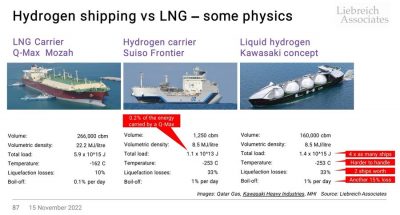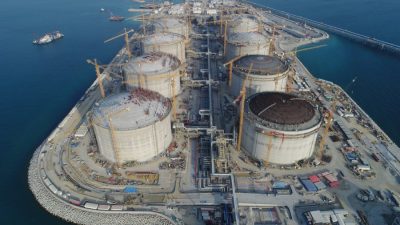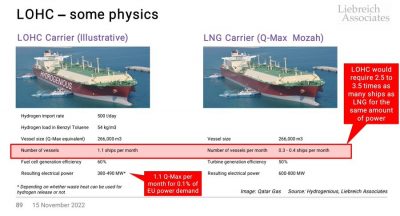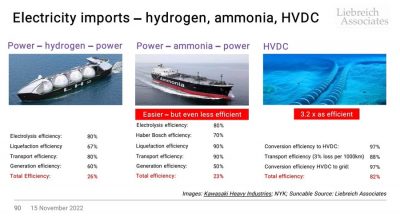Importing lots of hydrogen over vast distances
Posted by Michael Liebreich in Energy storage 1 Comment» Thread for those who think we’re going to be importing lots of hydrogen over vast distances.
Thread for those who think we’re going to be importing lots of hydrogen over vast distances.
Shipping liquid hydrogen is not going to be a thing. To understand why, you need to understand that hydrogen is basically liquid, -253C escapey, explodey expanded polystyrene.

2. What this means is that any comparison with LNG is, ahem, bollox. We cracked LNG shipping, but it’s the most expensive gas on the market. And shipping the same BTUs as liquid hydrogen would require 3-4 times as many ships. Because of physics, not lack of learning, scale, etc.

3. Liquifying hydrogen is also a complete bear.
It currently consumes 35% to 45% of the Lower Heating Value of the input. If you don’t know about LHV and HHV, or about ortho-para isomer conversion, please read more and tweet less about liquid hydrogen!
https://pubs.rsc.org/en/content/art
4. Then there’s the fun stuff.
Hydrogen, which is liquid at -253C and much less dense than LNG, is likely to have up to 9x more boil-off (ie loss during transit, of which only part fuels the ship) and 2x more “sloshing”, which is dangerous.
https://www.mdpi.com/1996-1073/15/6/2046/htm
5. Can liquid hydrogen re-use infrastructure created for LNG?
Power supply and docks, sure; 70% of pipelines may be re-purposed. But not the liquefaction and gasification plants, compressors, storage tanks, etc. Vital to listen to independent experts!
https://www.linkedin.com/pulse/re-using-lng-terminals-hydrogen-paul-martin/

6. OK, are we done with the absurd notion of transporting liquid hydrogen?
In fact, LH2 will have no role anywhere in energy and transport. The only way to transport hydrogen economically is by pipeline. Or of course as ammonia, or in metal hydride or liquid organic carriers.
7. Let’s deal with Liquid Organic Hydrogen Carriers (LOHC).
Bung H2 into benzyl toluene and it’s stable at ambient temp & pressure. Great! Except you get just 54kg H2 for every m3 of solvent, even worse than liquid hydrogen. May work for stationary storage, useless for shipping.

8. Metal hydrides have the same problems as LOHC for shipping
The energy carried per unit volume is just too low to be economically viable. AND you have to send the ship back full (fuel cost), AND you have to apply heat at the destination to release the hydrogen (losses).
9. So that leaves ammonia. Yes, we can and will ship ammonia.
The question is WHY SHIP AMMONIA? If it’s for fertiliser or industrial use, go clean ammonia! But if it’s to import green electricity, nested inefficiencies mean huge cycle losses – and HVDC kills it. Systems thinking!

10. Japan is hanging its entire decarbonisation strategy on clean ammonia imports.
OK it can’t import power via HVDC, but it can do nuclear and vast amounts of offshore wind. Betting on ammonia will mean punitive power prices and de-industrialisation.
11. Finally, efuels.
Yes! E-methanol for shipping fuels solves the serious safety issues associated with ammonia. E-jet fuel may be needed for aviation if SAF is volume-limited. But e-fuels will be very expensive. You need HYDROGEN and CARBON and you need to COMBINE them.
12. So that’s why imports of hydrogen and its derivatives will be far lower than you might think. Clean Hydrogen is vitally important to decarbonise certain sectors, but claims it can deliver 20% of CO2 abatement by 2050 are an order of magnitude too high. Electrify everything!
13. If there’s one thing less likely than shipping liquid hydrogen, it’s H2 for longhaul aviation.
Again, it’s volumetric density that kills it. And if you say ‘flying wing’, I say ‘all tanks at -253C, all planes and airports redesigned from scratch.’ E-jet maybe, probably SAF.
14. Finally (?) methanation.
You could ship synthetic LNG, but why would you? Getting the carbon from DAC will be very expensive; from biomass, probably not available where hydrogen is cheap; from fossil fuels, WTAF! Easier to ship fossil LNG, then capture and return the CO2.
15. BTW, density is also a huge problem for truck fueling infra.
Tube trailers carrying 750kg of compressed H2 would require 16x more deliveries than the equivalent energy via diesel tankers. Even liquid H2 tankers would need 4x as many deliveries. No H2 pipeline, no truckstop.
Michael Liebreich MA MBA OLY HonFEI
Twitter @MLiebreich





1 reply on “Importing lots of hydrogen over vast distances”
Transporting liquid hydrogen over long distances is impractical due to its extreme conditions and inefficiencies compared to LNG.